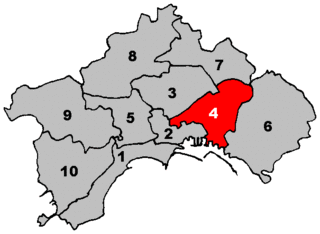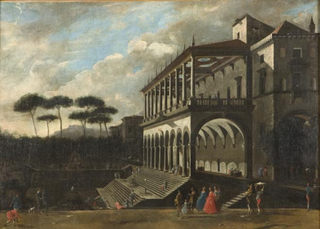Poggio is an Italian word meaning "knoll". It may refer to:

Regola is the 7th rione of Rome, Italy, identified by the initials R. VII, and belongs to the Municipio I. The name comes from Arenula, which was the name of the soft sand that the river Tiber left after the floods, and that built strands on the left bank.

Vomero is a bustling hilltop district of metropolitan Naples, Italy — comprising approximately two square kilometres (0.77 sq mi) and a population of 48,000.

Castel Capuano is a castle in Naples, southern Italy. It takes its name from the fact that it was at that point in the city walls where the road led out to the city of Capua. The castle is at the southwest end of via dei Tribunali, and until recently housed the Naples Hall of Justice, which has now moved to the new Civic Center, the Centro Direzionale.

The Centro direzionale is a business district in Naples, Italy close to the Napoli Centrale railway station. Designed by the Japanese architect Kenzō Tange, the entire complex was completed in 1995. It is the first cluster of skyscrapers to have been built in Italy or southern Europe.

Via dei Tribunali is a street in the old historic center of Naples, Italy.

Pendino is one of the 30 quartieri of Naples, southern Italy.

The Four Days of Naples was an uprising in Naples, Italy, against Nazi German occupation forces from September 27 to September 30, 1943, immediately prior to the arrival of Allied forces in Naples on October 1 during World War II.

The districts of Naples are the sectors that, within the city, are identified by particular geographical and topographical, functional and historical features.

The Fourth Municipality is one of the ten boroughs in which the Italian city of Naples is divided.
The Cemetery of the 366 Fossae or Cimitero di Santa Maria del Popolo or Cimitero dei Tredici was built in 1762 a short distance from the then-dilapidated Villa Poggio Reale, and is located on a terrace of a hill overlooking the Poggioreale neighborhood of Naples, Italy. It is near the monumental Cemetery of Poggioreale, which was built on top of the ruined villa. The architect was the Florentine Ferdinando Fuga.

The Cemetery of Poggioreale is one of the major cemeteries in Naples, Italy. It is also known as Camposanto Nuovo, to distinguish it from Camposanto Vecchio, which is now known as Cemetery of the 366 Fossae. It is bordered by the Largo Santa Maria del Pianto, Via del Riposo, Via Santa Maria del Pianto, and via nuova Poggioreale, and is built upon the ruins of Alphonso II's Villa Poggio Reale.

The Catacombs of Saint Gaudiosus are underground paleo-Christian burial sites, located in the northern area of the city of Naples.

The Poggio Reale villa or Villa Poggio Reale was an Italian Renaissance villa commissioned in 1487 by Alfonso II of Naples as a royal summer residence. The Italian phrase "poggio reale" translates to "royal hill" in English. The villa was designed and built by Giuliano da Maiano and located in the city of Naples, in the district now known as Poggioreale, between the present Via del Campo, Via Santa Maria del Pianto and the new and old Via Poggioreale. At the time it was built, a period when the capital city of the Kingdom of Naples was renowned for elegant homes with expansive vistas of the surrounding landscape and Mount Vesuvius, the villa was outside the city walls of Naples and was one of the most important architectural achievements of the Neapolitan Renaissance. Imitated, admired, robbed of its treasures by another king, left in ruins and partially destroyed, the summer palace of the King of Naples lives on in name as a style.

Santa Maria del Pianto is a church in Naples, Italy. It was built in 1657 to commemorate the victims of the 1656 plague, buried in the nearby Grotta degli Sportiglioni. Its site was the original core of the Cemetery of Poggioreale on via vicinale di Santa Maria del Pianto. It was designed by Francesco Antonio Picchiatti

The Patron Saints of Naples Adoring Christ on the Cross is a 1660–1661 oil painting by the Italian Baroque artist Luca Giordano, now in the National Museum of Capodimonte in Naples. In the bottom left are the saints Baculus, Euphebius, Francis Borgia, Aspren and Candida, whilst in the top left is God the Father.
Centro Direzionale will be a station on line 1 of the Naples Metro, adjacent and connected through an underground passage to the Naples Centro Direzionale station of the Circumvesuviana railway. The construction site was inaugurated on 2 August 2014.
Capodichino will be a station on line 1 of the Naples metro, located near the Naples-Capodichino airport. It is named after the suburb Capodichino of Naples.
Naples (Italy) and its immediate surroundings preserve an archaeological heritage of inestimable value and among the best in the world. For example, the archaeological park of the Phlegraean Fields is directly connected to the centre of Naples through the Cumana railway, and the nearby sites of Pompeii, Herculaneum, Stabiae and Oplontis are among the World Heritage Sites of UNESCO.
Tribunale will be a station on Line 1 of the Naples Metro and will rise in Via Domenico Aulisio. The previous station will be Centro Direzionale, while the next one will be Poggioreale.















